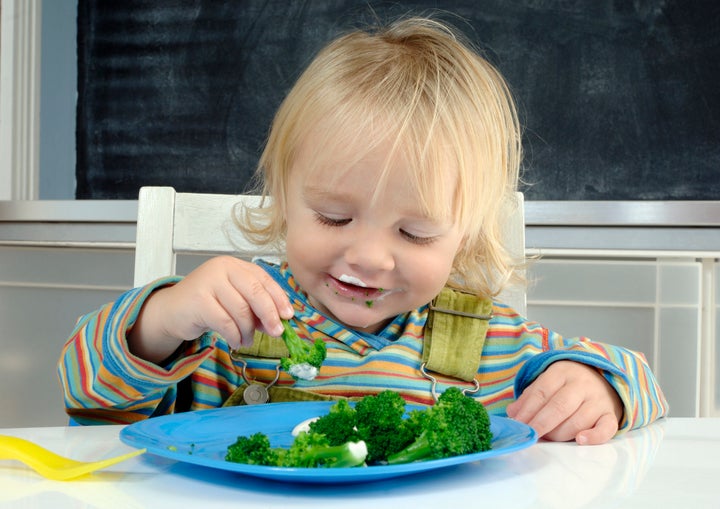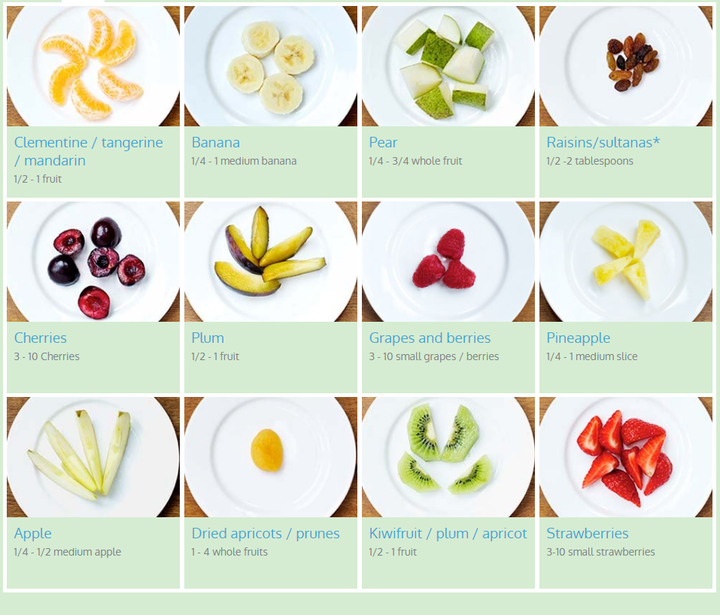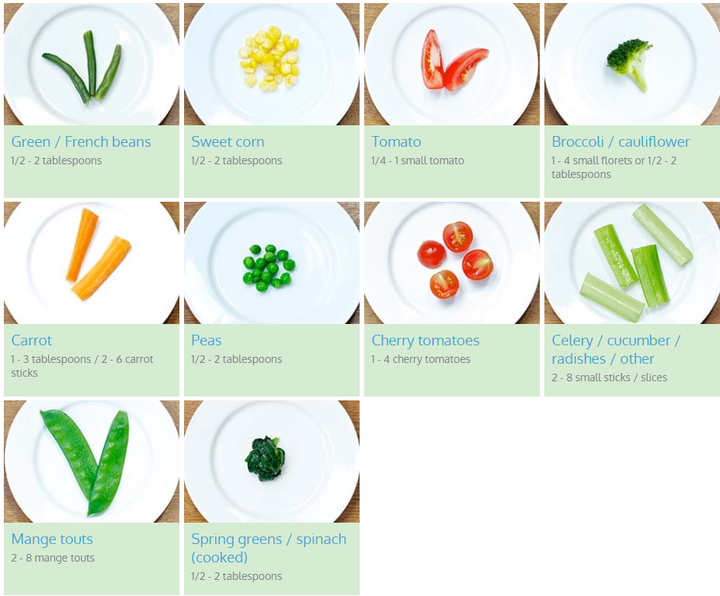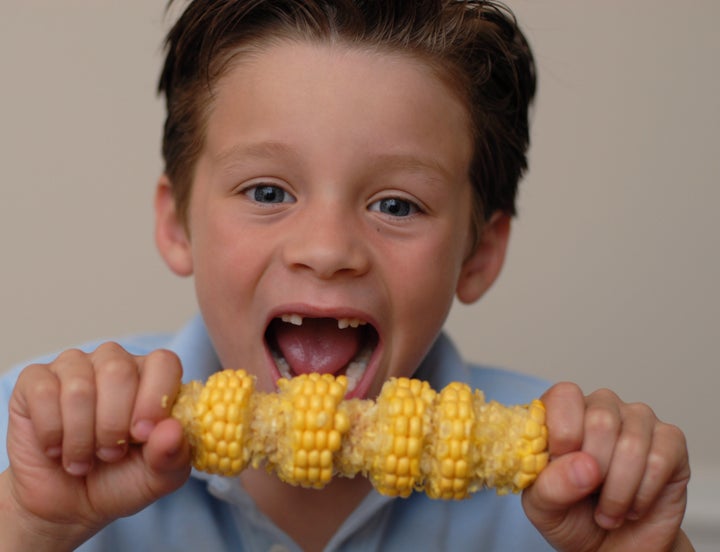Fruit and vegetables are a good source of vitamins and minerals, including folate, vitamin C and potassium. They’re also an excellent source of dietary fibre, which can help to maintain a healthy gut, and are low in fat and calories (provided you don’t fry or roast them in tons of oil!).
By encouraging your children to enjoy eating a variety of fruit and vegetables, you’re helping meet their energy needs as they grow whilst protecting their long-term health by reducing the risk of serious health conditions including obesity and type 2 diabetes.

Why 5-a-day?
The 5-a-day campaign is based on advice from the World Health Organisation, which recommends eating a minimum of 400g of fruit and vegetables a day to lower the risk of serious health problems. This recommendation equates to five portions of fruit and vegetables (around 80g each).
The Department of Health launched the 5-a-day campaign in 2003. But the most recent government backed National Diet and Nutrition Survey found only eight per cent of children aged 11 to 18 years met the 5-a-day recommendation, while in adults the results were less woeful but still unimpressive: 27% of those aged 19 to 64 years and 35% of those aged 65 and over.
We all need to eat more fruit and vegetables, and that starts with introducing our children to the delicious tastes and textures of different fruits and vegetables.

What does a ‘portion’ look like?
A portion of fruit (80g) is roughly equivalent to:
- Half a large fruit, eg, a slice of melon or half a grapefruit.
- 1 medium size fruit, eg, an apple.
- 2 small size fruits, eg, plums or satsumas.
- A portion of dried fruit (30g) is roughly equivalent to:
- a heaped tablespoon of dried fruit
A portion of vegetables (80g) is roughly equivalent to:
- 3 heaped tablespoons of peas, carrots or sweetcorn
- 2 broccoli spears
The amount of fruit and vegetables that children should eat depends on their size and age – there are no set rules. But a good guide to a portion size is the amount they can fit into the palm of their hand.
Increase the portion size gradually, so by the age of 10 they are eating the same size fruit and vegetable portions as adults. (A note of caution: this is NOT the same advice for other food groups and a 10-year-old should not be eating the same sized meal as an adult.)
The pictures below show portion size guides from the Infant and Toddler Forum for children aged 1-4 years. The ITF, an organisation made up of experts from paediatrics, dietetics, child psychology and specialising in early years nutrition and development, adds this caveat: “The amount of food that young children eat varies from day to day and meal to meal. Use our portion size ranges as a guide on how much to offer your 1-4 year olds, then allow children to eat to their appetite. Taller or more active children will eat larger portions than shorter or less active children.”
“For fruit and vegetables offer at least one to two servings at each meal and also offer them with some snacks. These are low energy, high nutrient foods - allow toddlers to eat larger portions if they wish to. Foods marked with an asterisk * should be limited to mealtimes and no more than one snack per day because of their sugar content.” You can view the full portion size guide here.
Images reproduced with the kind permission of the Infant Toddler Forum.
Fruit recommendations

Vegetable recommendations

So what fruit and vegetables count towards your child’s 5-a-day?
Almost all fruit and vegetables count and they can be fresh, frozen, canned and dried. You can ‘hide’ vegetables in pasta sauces and stews. Beans and pulses like lentils and kidney beans count too, but as one portion no matter how much you eat. In fact, it’s only really potatoes that don’t count.
“Frozen vegetables can be just as nutritious as fresh as they’re frozen at the point of harvest,” says Laura Clark, a registered dietitian, member of the British Dietetic Association and mum-of-two.
“In some cases you could argue that frozen vegetables contain more nutritional value than ‘fresh’ options that have been at the back of a fridge for a week or displayed on supermarket shelves. They also appeal to children because pieces are generally cut small and they’re brightly coloured.
“If you’re giving your child canned fruit, choose a tin that has natural juices, not syrup, and drain most of the juice away.
“The ideal way to give children vegetables is raw, like carrot sticks, or steamed, so the nutrients aren’t leeched out into boiling water.”
Hang on, potatoes don’t count?
No, potatoes are a starchy food, and great source of energy, fibre, B vitamins and potassium, particularly if you eat the skins. We also get a lot of our vitamin C from potatoes because we eat so many. When eaten as part of a meal, potatoes are generally used in place of other sources of carbohydrate, such as bread, pasta or rice. Because of this, they don’t count towards your 5-a-day. The same goes for yams, cassava and plantain.
But sweet potatoes, parsnips, swedes and turnips do count towards your 5-a-day, because they are usually eaten in addition to the starchy food part of the meal.
What about tomato ketchup?
Parents of particularly picky children used to salve their conscience with the idea that tomato ketchup counted. Not so, says Judy More, paediatric dietitian and a spokesperson for the Infant Toddler Forum decisively: “Tomato ketchup is very processed and sweetened tomato and does not taste like a fresh tomato so it does not count.”
Do smoothies count as fruit?
A maximum of one 100ml glass of smoothie does count as one of your 5-a-day. Drinking more, doesn’t count as more than one portion. BUT they do contain a lot of fruit sugar and won’t encourage your child to enjoy the texture of fruits, so always go for non-smoothied fruit first.
Juiced fruit, which eliminates all fibre, is not a good option, because of the risk of dental decay, and should always be diluted with water. Better still, encourage your children to drink water and eat pieces of fruit.

Why can’t my kids just eat one sort of fruit and vegetable I know they really like?
To get the most out of your 5-a-day, your five portions should include a variety of fruit and vegetables. This is because different fruits and vegetables contain different combinations of fibre, vitamins, minerals and other nutrients.
“Variety is key,”says Laura Clark. “As parents, we’re all guilty of keeping to a small repertoire for fear of food wastage. But research has shown that children have to be offered a food up to 15 times before they’ll eat it happily. They’re also more likely to try new fruits and vegetables when they are offered alongside something familiar which they like.
“Babies who are being weaned and are given a wide variety of fruit and veg between the ages of seven and eight months are more likely to be better vegetable eaters by the time they’re 12 months old, so that window of opportunity is very important too.
“The more diversity of fruit and vegetables eaten, the better for your child’s gut bacteria, which will benefit their long-term immunity.”
What fruit and vegetables should parents prioritise?
“None – any pieces of any fruit and vegetables are good,” says Judy More.
Tips for encouraging children to eat more fruit and veg from Judy More
Parents and carers should be role models by eating fruits and vegetables themselves as younger children learn by copying.
Serve fruit at every breakfast and fruit and veg at both main meals so that children see this as normal.
Stir fry or roast vegetables as this gives them a less bitter taste than boiling or steaming.
Do not substitute pouches of pureed baby food as substitutes for pieces of fruit and veg for younger children.
In social gatherings sit reluctant eaters next to peers who eat fruit and vegetables enthusiastically.